2013届高考英语语法复习之代词和it的用法(共71张PPT)
文档属性
| 名称 | 2013届高考英语语法复习之代词和it的用法(共71张PPT) |  | |
| 格式 | zip | ||
| 文件大小 | 1.1MB | ||
| 资源类型 | 教案 | ||
| 版本资源 | |||
| 科目 | 英语 | ||
| 更新时间 | 2012-07-22 10:44:53 | ||
图片预览

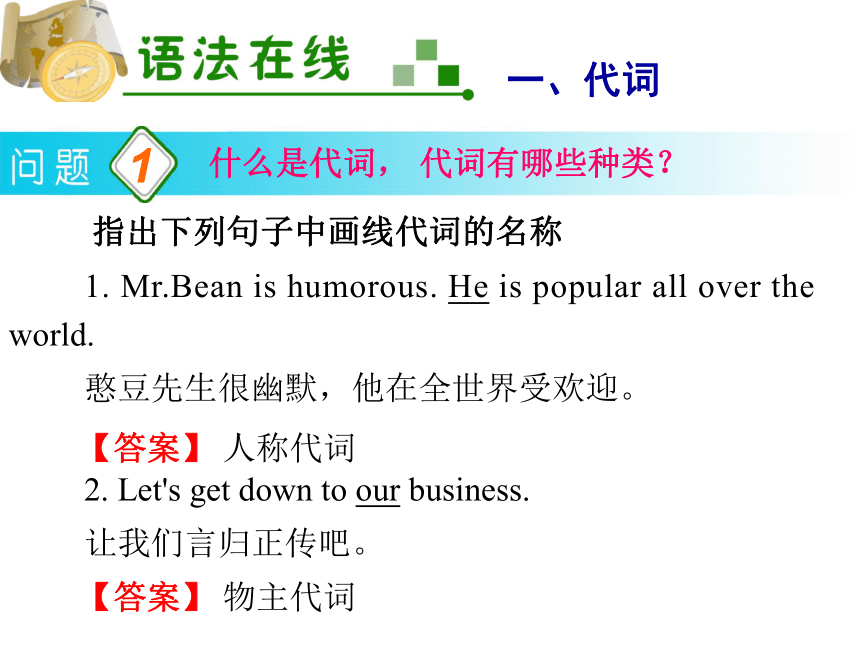
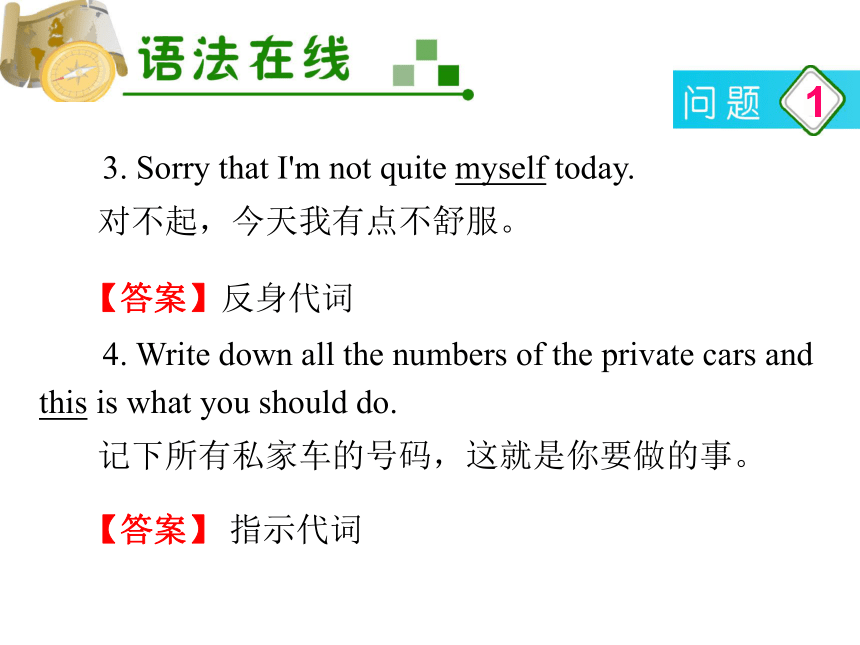

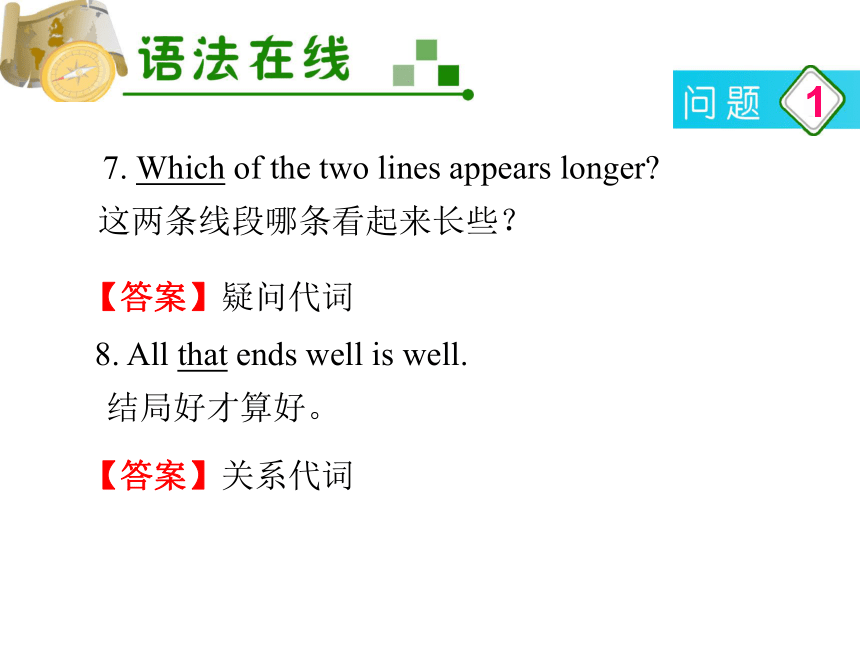
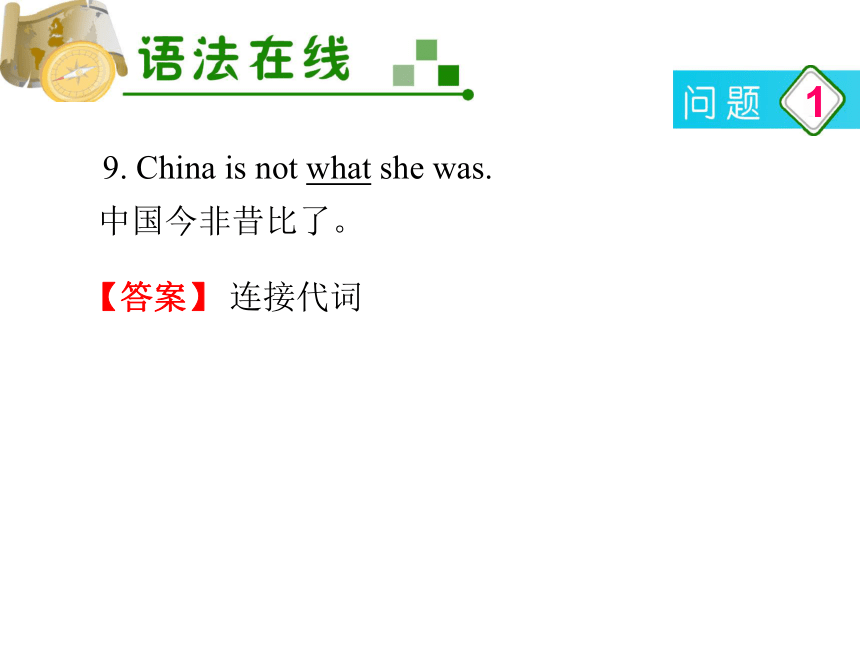
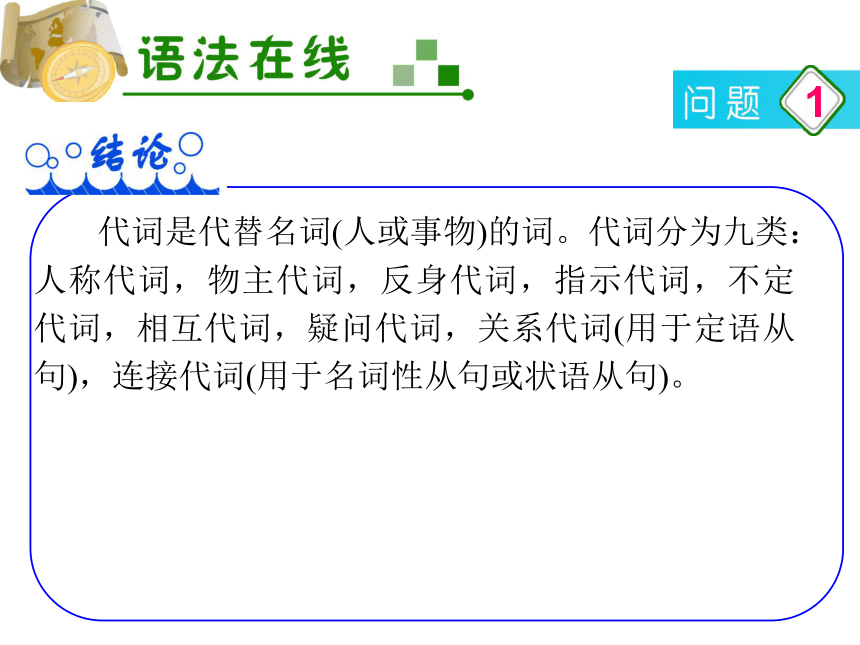
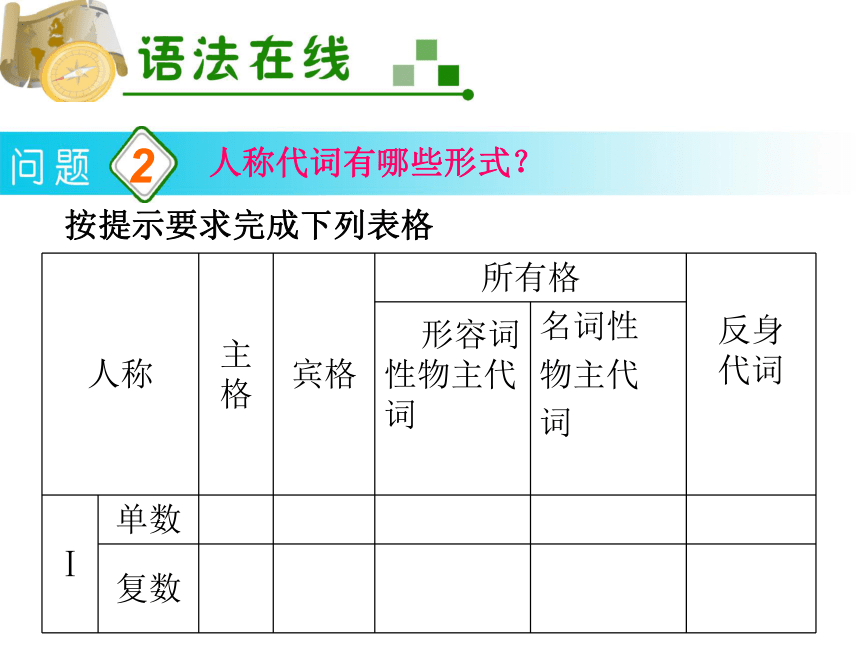
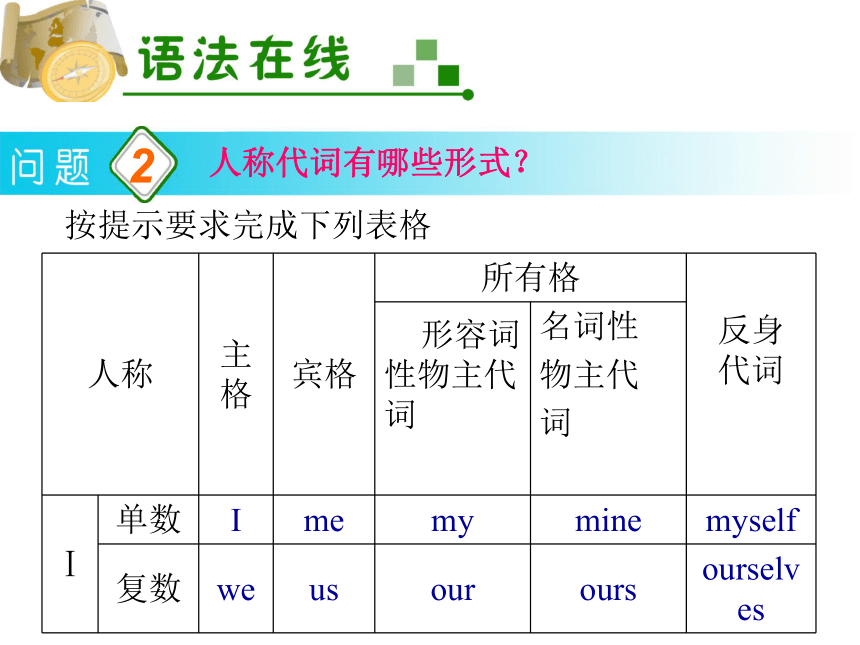
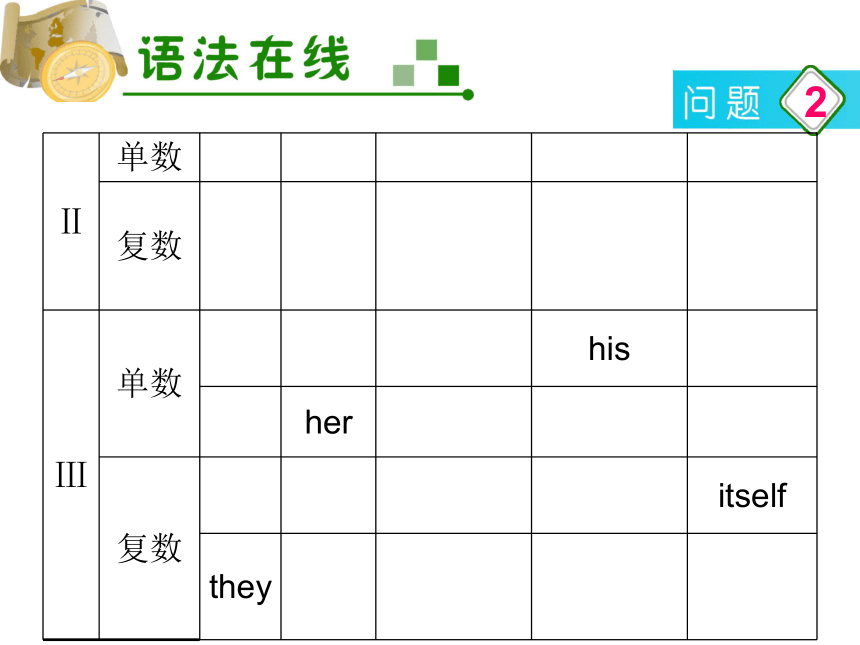
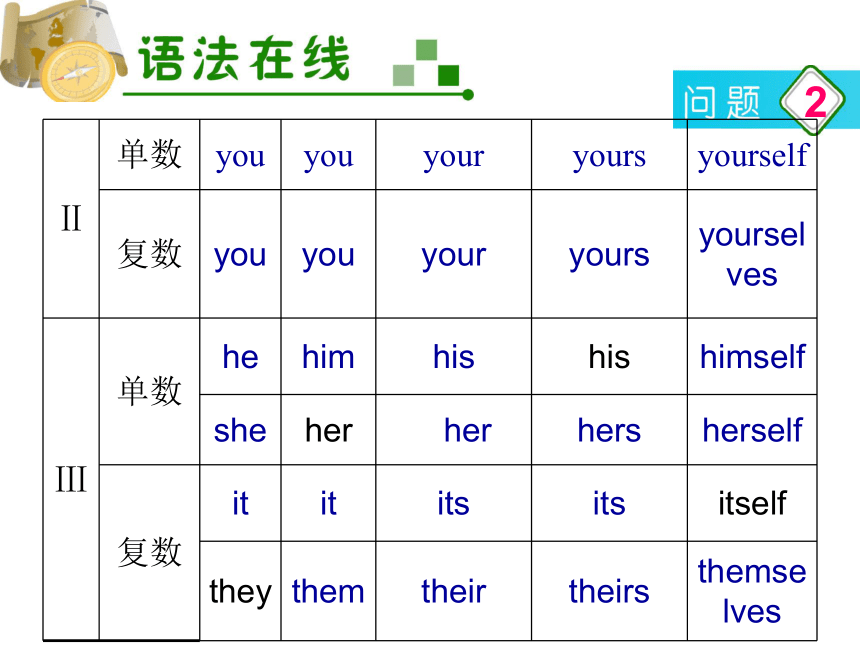
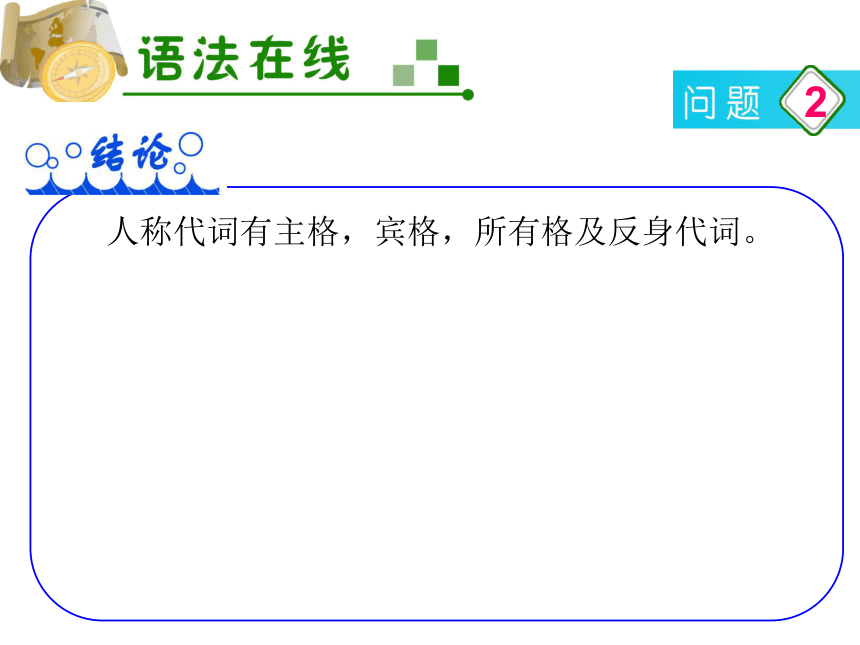
文档简介
(共71张PPT)
2013届高考英语语法复习之
代词和it的用法
指出下列句子中画线代词的名称
1. Mr.Bean is humorous. He is popular all over the world.
憨豆先生很幽默,他在全世界受欢迎。
1
什么是代词, 代词有哪些种类?
【答案】 人称代词
【答案】 物主代词
2. Let's get down to our business.
让我们言归正传吧。
一、代词
3. Sorry that I'm not quite myself today.
对不起,今天我有点不舒服。
1
【答案】反身代词
4. Write down all the numbers of the private cars and this is what you should do.
记下所有私家车的号码,这就是你要做的事。
【答案】 指示代词
5. Everything is better than none.
有比没有要好。
1
【答案】不定代词
6. All of us should help each_other.
我们应该互相帮助。
【答案】 相互代词
7. Which of the two lines appears longer
这两条线段哪条看起来长些?
1
【答案】疑问代词
8. All that ends well is well.
结局好才算好。
【答案】关系代词
9. China is not what she was.
中国今非昔比了。
1
【答案】 连接代词
1
代词是代替名词(人或事物)的词。代词分为九类:人称代词,物主代词,反身代词,指示代词,不定代词,相互代词,疑问代词,关系代词(用于定语从句),连接代词(用于名词性从句或状语从句)。
按提示要求完成下列表格
2
人称代词有哪些形式?
人称 主格 宾格 所有格 反身
代词
形容词性物主代词
名词性
物主代
词
Ⅰ 单数
复数
按提示要求完成下列表格
2
人称代词有哪些形式?
人称 主格 宾格 所有格 反身
代词
形容词性物主代词
名词性
物主代
词
Ⅰ 单数 I me my mine myself
复数 we us our ours ourselves
2
Ⅱ 单数
复数
Ⅲ 单数 his
her
复数 itself
they
2
Ⅱ 单数 you you your yours yourself
复数 you you your yours yourselves
Ⅲ 单数 he him his his himself
she her her hers herself
复数 it it its its itself
they them their theirs themselves
2
人称代词有主格,宾格,所有格及反身代词。
指示代词,反身代词,相互代词及疑问代词分别包含哪些词?
把下列代词归入正确的类别
this, that, itself, myself, each other, who, what
3
【答案】 1.指示代词:this; that
2.相互代词:each other
3.疑问代词: who; what
3
1.指示代词:this, that,these,those
2.相互代词:each other, one another
3.疑问代词: who, which, whom, whose, what
注意:关系代词和连接代词在后面有专门讲解,故暂不考虑其类型。
4
常见不定代词的含义怎样?
完成表格,注意不定代词的基本含义和数量意义
不定
代词 词性 基本含义 具体数量意义或是否可数
all
both
each
4
常见不定代词的含义怎样?
完成表格,注意不定代词的基本含义和数量意义
不定
代词 词性 基本含义 具体数量意义或是否可数
all 代词/形容词 全部(的) 三个或以上或不可数
both 代词/形容词 两个都 两个
each 代词/形容词 每个 两个或以上
4
不定
代词 词性 基本含义 具体数量意义或是否可数
every
either
neither
one
none
4
不定
代词 词性 基本含义 具体数量意义或是否可数
every 形容词 每个 三个或以上
either 代词/形容词 两个中任意一个 两个
neither 代词/形容词 两个都不 两个
one 代词 一个 其中一个
none 代词/副词 三个或以上中没有一个 三个或以上
4
不定
代词 词性 基本含义 具体数量意义或是否可数
little
few
many
much
other
4
不定
代词 词性 基本含义 具体数量意义或是否可数
little 代词/形容词 几乎没有一点儿 不可数
few 代词/形容词 几乎没有几个 可数
many 代词/形容词 许多 可数
much 代词/形容词 许多 不可数
other 形容词 别的 可数
4
不定
代词 词性 基本含义 具体数量意义或是否可数
another
The
other
others
The
others
some
4
不定
代词 词性 基本含义 具体数量意义或是否可数
another 代词/形容词 另一个 多者中的另一个
The
other 代词/形容词 另一个 两者中的另一个
others 代词 其他的 多者中的其余
The
others 代词 其他的 特定范围下的其余
some 代词/形容词 一些/某一个 可数或不可数
4
不定
代词 词性 基本含义 具体数量意义或是否可数
any
no
4
不定
代词 词性 基本含义 具体数量意义或是否可数
any 代词/形容词 任何一个/任何/一些 可数或不可数
no 形容词 没有 可数或不可数
4
1.不定代词的概念:不指明代替任何特定名词或形容词的代词。能单独使用。
2.不定代词的用法:不定代词在名中可作主语、定语,作定语时可修饰可数名词和不可数名词。
4
3.不定代词有一定的数量意义。
以all为例,其单独使用时作代词:作主语如All is over.作定语时修饰名词,如All lies don't hold water.单独使用或修饰可数名词时,表达三个以上的概念,如All are here.或 All the students are here.中“所有学生”的人数应该为三个或三个以上。all修饰不可数名词,表示全部,所有的事物,如All the water is polluted.意为“所有的水已被污染。”
翻译下列句子,体会连写和分写的不定代词的含义
1. Everyone was born equal.
5
连写和分写的不定代词用法上有何区别?
【答案】人人生而平等。
【答案】我们班每个学生都有良好的环保意识。
2. Every one of the students in our class has good sense of environmental protection.
3. They ate every one of the mooncakes.
5
【答案】他们把月饼都吃光了。
5
every, any, some, no均可与one构成不定代词,连写与分写用法上有很大区别,以every和one连用为例,连写的everyone只能表人,不带of结构;分写的every one 常带of结构,既可以表人,也可以表物。这是连写和分写的不定代词用法上的基本区别。但切记no one 及none两词的用法刚好与此规律相反。即分写的no one只能表人,不带of结构;连写的none 常带of结构,既可以表人,也可以表物。简单回答
5
中,none用以回答how many/how much提出的问 题,no one 则回答who提出的问题。
6
some与any用法上有何区别?
用some或any填空
1. The old Frenchman has __________Chinese paintings collected by his cousin.
2. __________question is welcome!
3. __________ parents expect too much from their children while others have no confidence in what is done by their kids.
some
Any
Some
4. For __________ reason, I have to say good bye to all of my lovely colleagues.
5. The package couldn't be mine, for I don't have __________ relatives here.
6. I'd like you to lend me __________ money. Do you have__________?
7. — Do you feel __________better today
— Thank you. I feel much better now.
8. I don't know his exact age. He is __________ 30 years old, I think.
6
some
some
some
any
some
any
6
some常用于肯定句, 接复数可数名词及不可数名词,表“一些”;接可数名词单数表“某个”,接数词表“大约”;用于疑问句表“请求或期待对方肯定的回答”。any可与单、复数可数名词及不可数名词连用,多用于疑问、否定或条件句,用于肯定句时表“任何(一个)”。
7
one, it与that用法上有何区别?
用one, it或that填空
1. A desk made of wood lasts longer than __________ made of plastics.
2. This news is less exciting than __________.
3. There is only one dictionary left in the bookstore. Please go to buy__________.
one
that
it
7
1. one, it,that三者均为代词;
2. one只能代可数名词单数,表示泛指,其复数形式为ones;
3. that既可以代可数名词又可以代不可数名词,强调与this的对应性。代可数名词时,其复数形式为those;
7
4. it有明显的特指性,确定性,指代上文提到的具体事物, 既可以代可数名词又可以代不可数名词,代可数名词时,其复数形式为they/them。
8
如何区别each, every, both, all, either, neither, none的用法?
选用上述不定代词填空,体会其含义
1. Look! __________ of his hands is covered with muddy.What a naughty boy!
2. Look! __________ of his hands are covered with muddy.What a naughty boy!
Each/Either
Both
3. __________ student in our school wears school uniform.
4. __________ of his parents is from Hawaii. They __________ come from San Francisco.
5. __________ of the answers are not right. Some of them are apparently wrong.
6. __________ his ears don't need hearing aid. His right ear is in good order.
7. __________ employee isn't well paid and only those having much experience are.
8
Every/Each
both
All
Both
Every/Each
Neither
8. — Would you like coffee or tea
— __________will do.
8
Either
8
1.every和each均可充当形容词,接单数可数名词,意为“每个”,但前者强调个体,可以充当代词,而且可用于两个的“每个”;后者强调整体,用于两个以上的“每个”,不可以充当代词。Each/Every…not和Not every/each…均表部分否定,意为“并非每个都”。
2. 既可以充当代词又可以充当形容词,意为“两个中的任意一个”,用法为either+单数名词或
8
either+of the+复数名词。但要注意其两种含义:选择性用法和兼容性用法。如:You may sit on either end of the bench.句意为“你可以坐这条凳的任意一头”,事实上“你要么坐这头要么坐那头, 因为不能同时坐两头”,此为其选择性用法。又如:Either side of the road is lined up with trees. 句意为“路的两边有树”,指的是“两边都有树”,不能理解为“这边有,那边就不能有”,此为其兼容性用法。
8
3. both意为“两个都”,接并列主语,用于both A and B结构,或接可数名词复数或用于Both of the +可数名词复数。Both…not…=Not both…为部分否定,意为“并非两个都”。其完全否定为Neither of the…意为“ 两个都不”。
4. all意为“三个(含)以上都”,接并列主语,接可数名词复数或用于all of the +可数名词复数结构。接可数名词单数或不可数名词时,意为“整个/所有
8
的都”。如:All the books published in this press are uncopyrightable.这个出版社出版的所有书籍均无合法版权。 All the city is surrounded by water. 整个城市四面环水。 All the rubbish should be thrown away where further pollution won't be caused.所有垃圾应该投放到不会产生二次污染的地方。All…not…=Not all…为部分否定,意为“并非全都”。其完全否定为None of the…意为“所有的……都不”。
9
如何区别 other,the other, another, the others与others的用法?
选用上述不定代词填空,体会其含义
1. Some people think playing computer games benefits children a lot while __________hold the opposite view.
others
2. — Can I help you
— This radio doesn't work. Please show me __________.
3. I am just familiar with one of the two visitors to our school.__________ is strange to me.
4. Helping __________ people in danger is a good virtue.
9
another
other
The other
5. — Have you finished delivering the 108 letters of invitation
— Not yet. I have just delivered 60 of them and I am to deliver__________ this afternoon.
9
the others
9
1. Some…; others…意为“一些……另一些……”,为固定句型,其中的“另一些(others)”为不确定对象。
2. another即可以单独作代词使用,也可接可数名词单数,表示“多者中的另一个”,也是不确定对象;
3. the other单独使用,也可接单数可数名词,只能指两者中的另一个,为确定对象;
9
4. other 只能作形容词,不可单独使用,后须接可数名词复数,相当于others;
5. the others单独使用或接可数名词复数,表一定范围中排除若干对象后剩下的其他人或物,为确定对象。
翻译下列句子
1. The frog is not a warm blooded animal. It is a cold blooded one.
1
it有哪些用法?
【答案】青蛙不是温血动物,它是冷血动物。
二、it的用法
2. Someone is ringing the doorbell. Go and see who it is.
【答案】有人在按门铃。去看看是谁。
3. What's this It's a book.
【答案】这是什么?这是一本书。
1
4. — Who is knocking at the door
— It's me.
【答案】——谁在敲门?
——是我。
5. What a long way it is from Beijing to London!
【答案】从北京到伦敦真远。
1
6. It is late autumn now.
【答案】现在是深秋。
7. It is rather cold today, isn't it
【答案】今天很冷,是不是?
1
8. — What's the cost of the dictionary
— It is sixty three yuan.
【答案】 ——那本词典多少钱?
——63元。
9. It's best to plant trees in spring because it's warmer.
【答案】春天是植树的最佳时节,因为天气更暖和。
1
10. It is dangerous walking on thin ice.
【答案】在薄冰上行走是危险的。
11. It is a fact that English is being accepted as an international language.
【答案】事实上,英语是公认的国际语言。
1
12. I don't think it possible to master a foreign language without much memory work.
【答案】我认为不进行大量的记忆学好英语是不可能的。
13. Do you consider it necessary sending more people over
【答案】你觉得再派一些人去有必要吗?
1
14. They found it strange that no one would take the money.
【答案】他们感到奇怪,谁也不要这笔钱。
15. It was I who met him in the park last week.
【答案】是我上星期在公园遇到他的。
1
16. When was it that you got to know her
【答案】你是在什么时候认识她的?
17. It is white that they painted the house.
【答案】他们把房子漆成的是白色。
1
18. It is a chief engineer that he becomes now.
【答案】他现在担任的是总工程师。
1
在英语中,it的使用相当广泛,它既可用作代词,如人称代词、指示代词及非人称代词, 也可用作引导词和强调结构中的强调词,其具体用法如下:
一、it作代词
1.用作人称代词(personal it)
代替前文提到过的事物或不明身份的人,it作真实主语或宾语。
1
2.用作指示代词(demonstrative it)
相当于this或that,it有时不特指某件东西,而代表前面已提到的或将会发生的某件事情。
3.用作非人称代词(impersonal it)
代词it可用来指除人以外的一切生物和事物,无阴阳性别之分。可指时间、距离、度量、价值、自然现象(天气、气体、阴暗等)。
1
二、it作引导词
1.作形式主语(formal subject)
当主语是动词不定式短语、动词的 ing形式短语和主语从句时,为了避免头重脚轻,往往把主语放在谓语动词之后,习惯上用it作形式主语来指代后面的真实主语。这个it称为引导词(anticipatory it),作形式主语,放在谓语动词后的主语是真正的主语。
1
2.作形式宾语(formal object)
当复合宾语中的宾语是动词不定式、动词 ing形式短语、宾语从句时,往往把宾语放在它的补足语后面,而把引导词it放在全句谓语动词和宾语补足语的中间。放在宾语补足语后面的宾语叫真正宾语,放在全句谓语动词和宾语补足语中间的引导词it叫形式宾语。
1
三、it用在强调结构中
当我们要强调句子的某一部分(通常总是主语,宾语或状语)时,常用强调结构。其形式为“it is (was)+被强调的部分+who (that)+句子的其他成分”。在这种结构中,it无实际意义,它只帮助改变一个句子的结构,使某一成分受到强调。
使用“It is/was…that…”强调句型要注意的几点:
1
1.被强调部分指人时,其后除了用that之外,也可用who或whom。强调的是主语时,使用who;强调的是宾语时,使用whom。
2.强调句的时态
一般说来,原句的谓语动词如果是现在或将来各种时态,则用句型“It is…that (who, whom)…”;如果原句谓语动词是过去各种时态,则用句型“It was…that (who, whom)…”。
1
3.在强调时间、地点、原因或方式状语时,不能用when, where, why或how,只能用that。如:
It was because her mother was ill that she didn't go with us.
就是因为她母亲病了,她才没跟我们一起去。
1
注意:可用“It is/was because…that…”结构强调because引导的原因状语从句,如上例所示,但不能用该结构强调由since或as引导的原因状语从句,如不能说:It is since everybody is here that let's begin our discussion.也不能说: It was as it was raining hard that they had to stay at home.
1
4.强调“not…until…”结构
在强调“not…until…”结构中由until短语(或从句)表示的时间状语时,要用固定的强调句型“It is/was not until…that …”。其中that从句中的谓语动词用肯定式。如:
My father did not come until 12 o'clock last night.
1
→It was not until 12 o'clock last night that my father came home.
昨晚直到12点我父亲才回家。
5.在强调一般疑问句中的某一成分时,主句要用一般疑问句的语序。如:Did this happen in Guangzhou
→Was it in Guangzhou that this happened
此事是在广州发生的吗?
1
6.特殊疑问句中只有疑问词可以强调,其强调结构是:“疑问词+is/was it+that…?”
7.可以强调宾语补足语,当连系动词不是be,表语部分是名词性词组时,也可使用这种结构强调表语,但是,当连系动词是be时,不能强调表语。
1
8.强调句的谓语动词除了可采用现在时和过去时的单数形式外,有时根据需要还可采用复杂的形式。如:
It must have been Mary that you saw just now.
你刚才看到的一定是玛丽。
1
2013届高考英语语法复习之
代词和it的用法
指出下列句子中画线代词的名称
1. Mr.Bean is humorous. He is popular all over the world.
憨豆先生很幽默,他在全世界受欢迎。
1
什么是代词, 代词有哪些种类?
【答案】 人称代词
【答案】 物主代词
2. Let's get down to our business.
让我们言归正传吧。
一、代词
3. Sorry that I'm not quite myself today.
对不起,今天我有点不舒服。
1
【答案】反身代词
4. Write down all the numbers of the private cars and this is what you should do.
记下所有私家车的号码,这就是你要做的事。
【答案】 指示代词
5. Everything is better than none.
有比没有要好。
1
【答案】不定代词
6. All of us should help each_other.
我们应该互相帮助。
【答案】 相互代词
7. Which of the two lines appears longer
这两条线段哪条看起来长些?
1
【答案】疑问代词
8. All that ends well is well.
结局好才算好。
【答案】关系代词
9. China is not what she was.
中国今非昔比了。
1
【答案】 连接代词
1
代词是代替名词(人或事物)的词。代词分为九类:人称代词,物主代词,反身代词,指示代词,不定代词,相互代词,疑问代词,关系代词(用于定语从句),连接代词(用于名词性从句或状语从句)。
按提示要求完成下列表格
2
人称代词有哪些形式?
人称 主格 宾格 所有格 反身
代词
形容词性物主代词
名词性
物主代
词
Ⅰ 单数
复数
按提示要求完成下列表格
2
人称代词有哪些形式?
人称 主格 宾格 所有格 反身
代词
形容词性物主代词
名词性
物主代
词
Ⅰ 单数 I me my mine myself
复数 we us our ours ourselves
2
Ⅱ 单数
复数
Ⅲ 单数 his
her
复数 itself
they
2
Ⅱ 单数 you you your yours yourself
复数 you you your yours yourselves
Ⅲ 单数 he him his his himself
she her her hers herself
复数 it it its its itself
they them their theirs themselves
2
人称代词有主格,宾格,所有格及反身代词。
指示代词,反身代词,相互代词及疑问代词分别包含哪些词?
把下列代词归入正确的类别
this, that, itself, myself, each other, who, what
3
【答案】 1.指示代词:this; that
2.相互代词:each other
3.疑问代词: who; what
3
1.指示代词:this, that,these,those
2.相互代词:each other, one another
3.疑问代词: who, which, whom, whose, what
注意:关系代词和连接代词在后面有专门讲解,故暂不考虑其类型。
4
常见不定代词的含义怎样?
完成表格,注意不定代词的基本含义和数量意义
不定
代词 词性 基本含义 具体数量意义或是否可数
all
both
each
4
常见不定代词的含义怎样?
完成表格,注意不定代词的基本含义和数量意义
不定
代词 词性 基本含义 具体数量意义或是否可数
all 代词/形容词 全部(的) 三个或以上或不可数
both 代词/形容词 两个都 两个
each 代词/形容词 每个 两个或以上
4
不定
代词 词性 基本含义 具体数量意义或是否可数
every
either
neither
one
none
4
不定
代词 词性 基本含义 具体数量意义或是否可数
every 形容词 每个 三个或以上
either 代词/形容词 两个中任意一个 两个
neither 代词/形容词 两个都不 两个
one 代词 一个 其中一个
none 代词/副词 三个或以上中没有一个 三个或以上
4
不定
代词 词性 基本含义 具体数量意义或是否可数
little
few
many
much
other
4
不定
代词 词性 基本含义 具体数量意义或是否可数
little 代词/形容词 几乎没有一点儿 不可数
few 代词/形容词 几乎没有几个 可数
many 代词/形容词 许多 可数
much 代词/形容词 许多 不可数
other 形容词 别的 可数
4
不定
代词 词性 基本含义 具体数量意义或是否可数
another
The
other
others
The
others
some
4
不定
代词 词性 基本含义 具体数量意义或是否可数
another 代词/形容词 另一个 多者中的另一个
The
other 代词/形容词 另一个 两者中的另一个
others 代词 其他的 多者中的其余
The
others 代词 其他的 特定范围下的其余
some 代词/形容词 一些/某一个 可数或不可数
4
不定
代词 词性 基本含义 具体数量意义或是否可数
any
no
4
不定
代词 词性 基本含义 具体数量意义或是否可数
any 代词/形容词 任何一个/任何/一些 可数或不可数
no 形容词 没有 可数或不可数
4
1.不定代词的概念:不指明代替任何特定名词或形容词的代词。能单独使用。
2.不定代词的用法:不定代词在名中可作主语、定语,作定语时可修饰可数名词和不可数名词。
4
3.不定代词有一定的数量意义。
以all为例,其单独使用时作代词:作主语如All is over.作定语时修饰名词,如All lies don't hold water.单独使用或修饰可数名词时,表达三个以上的概念,如All are here.或 All the students are here.中“所有学生”的人数应该为三个或三个以上。all修饰不可数名词,表示全部,所有的事物,如All the water is polluted.意为“所有的水已被污染。”
翻译下列句子,体会连写和分写的不定代词的含义
1. Everyone was born equal.
5
连写和分写的不定代词用法上有何区别?
【答案】人人生而平等。
【答案】我们班每个学生都有良好的环保意识。
2. Every one of the students in our class has good sense of environmental protection.
3. They ate every one of the mooncakes.
5
【答案】他们把月饼都吃光了。
5
every, any, some, no均可与one构成不定代词,连写与分写用法上有很大区别,以every和one连用为例,连写的everyone只能表人,不带of结构;分写的every one 常带of结构,既可以表人,也可以表物。这是连写和分写的不定代词用法上的基本区别。但切记no one 及none两词的用法刚好与此规律相反。即分写的no one只能表人,不带of结构;连写的none 常带of结构,既可以表人,也可以表物。简单回答
5
中,none用以回答how many/how much提出的问 题,no one 则回答who提出的问题。
6
some与any用法上有何区别?
用some或any填空
1. The old Frenchman has __________Chinese paintings collected by his cousin.
2. __________question is welcome!
3. __________ parents expect too much from their children while others have no confidence in what is done by their kids.
some
Any
Some
4. For __________ reason, I have to say good bye to all of my lovely colleagues.
5. The package couldn't be mine, for I don't have __________ relatives here.
6. I'd like you to lend me __________ money. Do you have__________?
7. — Do you feel __________better today
— Thank you. I feel much better now.
8. I don't know his exact age. He is __________ 30 years old, I think.
6
some
some
some
any
some
any
6
some常用于肯定句, 接复数可数名词及不可数名词,表“一些”;接可数名词单数表“某个”,接数词表“大约”;用于疑问句表“请求或期待对方肯定的回答”。any可与单、复数可数名词及不可数名词连用,多用于疑问、否定或条件句,用于肯定句时表“任何(一个)”。
7
one, it与that用法上有何区别?
用one, it或that填空
1. A desk made of wood lasts longer than __________ made of plastics.
2. This news is less exciting than __________.
3. There is only one dictionary left in the bookstore. Please go to buy__________.
one
that
it
7
1. one, it,that三者均为代词;
2. one只能代可数名词单数,表示泛指,其复数形式为ones;
3. that既可以代可数名词又可以代不可数名词,强调与this的对应性。代可数名词时,其复数形式为those;
7
4. it有明显的特指性,确定性,指代上文提到的具体事物, 既可以代可数名词又可以代不可数名词,代可数名词时,其复数形式为they/them。
8
如何区别each, every, both, all, either, neither, none的用法?
选用上述不定代词填空,体会其含义
1. Look! __________ of his hands is covered with muddy.What a naughty boy!
2. Look! __________ of his hands are covered with muddy.What a naughty boy!
Each/Either
Both
3. __________ student in our school wears school uniform.
4. __________ of his parents is from Hawaii. They __________ come from San Francisco.
5. __________ of the answers are not right. Some of them are apparently wrong.
6. __________ his ears don't need hearing aid. His right ear is in good order.
7. __________ employee isn't well paid and only those having much experience are.
8
Every/Each
both
All
Both
Every/Each
Neither
8. — Would you like coffee or tea
— __________will do.
8
Either
8
1.every和each均可充当形容词,接单数可数名词,意为“每个”,但前者强调个体,可以充当代词,而且可用于两个的“每个”;后者强调整体,用于两个以上的“每个”,不可以充当代词。Each/Every…not和Not every/each…均表部分否定,意为“并非每个都”。
2. 既可以充当代词又可以充当形容词,意为“两个中的任意一个”,用法为either+单数名词或
8
either+of the+复数名词。但要注意其两种含义:选择性用法和兼容性用法。如:You may sit on either end of the bench.句意为“你可以坐这条凳的任意一头”,事实上“你要么坐这头要么坐那头, 因为不能同时坐两头”,此为其选择性用法。又如:Either side of the road is lined up with trees. 句意为“路的两边有树”,指的是“两边都有树”,不能理解为“这边有,那边就不能有”,此为其兼容性用法。
8
3. both意为“两个都”,接并列主语,用于both A and B结构,或接可数名词复数或用于Both of the +可数名词复数。Both…not…=Not both…为部分否定,意为“并非两个都”。其完全否定为Neither of the…意为“ 两个都不”。
4. all意为“三个(含)以上都”,接并列主语,接可数名词复数或用于all of the +可数名词复数结构。接可数名词单数或不可数名词时,意为“整个/所有
8
的都”。如:All the books published in this press are uncopyrightable.这个出版社出版的所有书籍均无合法版权。 All the city is surrounded by water. 整个城市四面环水。 All the rubbish should be thrown away where further pollution won't be caused.所有垃圾应该投放到不会产生二次污染的地方。All…not…=Not all…为部分否定,意为“并非全都”。其完全否定为None of the…意为“所有的……都不”。
9
如何区别 other,the other, another, the others与others的用法?
选用上述不定代词填空,体会其含义
1. Some people think playing computer games benefits children a lot while __________hold the opposite view.
others
2. — Can I help you
— This radio doesn't work. Please show me __________.
3. I am just familiar with one of the two visitors to our school.__________ is strange to me.
4. Helping __________ people in danger is a good virtue.
9
another
other
The other
5. — Have you finished delivering the 108 letters of invitation
— Not yet. I have just delivered 60 of them and I am to deliver__________ this afternoon.
9
the others
9
1. Some…; others…意为“一些……另一些……”,为固定句型,其中的“另一些(others)”为不确定对象。
2. another即可以单独作代词使用,也可接可数名词单数,表示“多者中的另一个”,也是不确定对象;
3. the other单独使用,也可接单数可数名词,只能指两者中的另一个,为确定对象;
9
4. other 只能作形容词,不可单独使用,后须接可数名词复数,相当于others;
5. the others单独使用或接可数名词复数,表一定范围中排除若干对象后剩下的其他人或物,为确定对象。
翻译下列句子
1. The frog is not a warm blooded animal. It is a cold blooded one.
1
it有哪些用法?
【答案】青蛙不是温血动物,它是冷血动物。
二、it的用法
2. Someone is ringing the doorbell. Go and see who it is.
【答案】有人在按门铃。去看看是谁。
3. What's this It's a book.
【答案】这是什么?这是一本书。
1
4. — Who is knocking at the door
— It's me.
【答案】——谁在敲门?
——是我。
5. What a long way it is from Beijing to London!
【答案】从北京到伦敦真远。
1
6. It is late autumn now.
【答案】现在是深秋。
7. It is rather cold today, isn't it
【答案】今天很冷,是不是?
1
8. — What's the cost of the dictionary
— It is sixty three yuan.
【答案】 ——那本词典多少钱?
——63元。
9. It's best to plant trees in spring because it's warmer.
【答案】春天是植树的最佳时节,因为天气更暖和。
1
10. It is dangerous walking on thin ice.
【答案】在薄冰上行走是危险的。
11. It is a fact that English is being accepted as an international language.
【答案】事实上,英语是公认的国际语言。
1
12. I don't think it possible to master a foreign language without much memory work.
【答案】我认为不进行大量的记忆学好英语是不可能的。
13. Do you consider it necessary sending more people over
【答案】你觉得再派一些人去有必要吗?
1
14. They found it strange that no one would take the money.
【答案】他们感到奇怪,谁也不要这笔钱。
15. It was I who met him in the park last week.
【答案】是我上星期在公园遇到他的。
1
16. When was it that you got to know her
【答案】你是在什么时候认识她的?
17. It is white that they painted the house.
【答案】他们把房子漆成的是白色。
1
18. It is a chief engineer that he becomes now.
【答案】他现在担任的是总工程师。
1
在英语中,it的使用相当广泛,它既可用作代词,如人称代词、指示代词及非人称代词, 也可用作引导词和强调结构中的强调词,其具体用法如下:
一、it作代词
1.用作人称代词(personal it)
代替前文提到过的事物或不明身份的人,it作真实主语或宾语。
1
2.用作指示代词(demonstrative it)
相当于this或that,it有时不特指某件东西,而代表前面已提到的或将会发生的某件事情。
3.用作非人称代词(impersonal it)
代词it可用来指除人以外的一切生物和事物,无阴阳性别之分。可指时间、距离、度量、价值、自然现象(天气、气体、阴暗等)。
1
二、it作引导词
1.作形式主语(formal subject)
当主语是动词不定式短语、动词的 ing形式短语和主语从句时,为了避免头重脚轻,往往把主语放在谓语动词之后,习惯上用it作形式主语来指代后面的真实主语。这个it称为引导词(anticipatory it),作形式主语,放在谓语动词后的主语是真正的主语。
1
2.作形式宾语(formal object)
当复合宾语中的宾语是动词不定式、动词 ing形式短语、宾语从句时,往往把宾语放在它的补足语后面,而把引导词it放在全句谓语动词和宾语补足语的中间。放在宾语补足语后面的宾语叫真正宾语,放在全句谓语动词和宾语补足语中间的引导词it叫形式宾语。
1
三、it用在强调结构中
当我们要强调句子的某一部分(通常总是主语,宾语或状语)时,常用强调结构。其形式为“it is (was)+被强调的部分+who (that)+句子的其他成分”。在这种结构中,it无实际意义,它只帮助改变一个句子的结构,使某一成分受到强调。
使用“It is/was…that…”强调句型要注意的几点:
1
1.被强调部分指人时,其后除了用that之外,也可用who或whom。强调的是主语时,使用who;强调的是宾语时,使用whom。
2.强调句的时态
一般说来,原句的谓语动词如果是现在或将来各种时态,则用句型“It is…that (who, whom)…”;如果原句谓语动词是过去各种时态,则用句型“It was…that (who, whom)…”。
1
3.在强调时间、地点、原因或方式状语时,不能用when, where, why或how,只能用that。如:
It was because her mother was ill that she didn't go with us.
就是因为她母亲病了,她才没跟我们一起去。
1
注意:可用“It is/was because…that…”结构强调because引导的原因状语从句,如上例所示,但不能用该结构强调由since或as引导的原因状语从句,如不能说:It is since everybody is here that let's begin our discussion.也不能说: It was as it was raining hard that they had to stay at home.
1
4.强调“not…until…”结构
在强调“not…until…”结构中由until短语(或从句)表示的时间状语时,要用固定的强调句型“It is/was not until…that …”。其中that从句中的谓语动词用肯定式。如:
My father did not come until 12 o'clock last night.
1
→It was not until 12 o'clock last night that my father came home.
昨晚直到12点我父亲才回家。
5.在强调一般疑问句中的某一成分时,主句要用一般疑问句的语序。如:Did this happen in Guangzhou
→Was it in Guangzhou that this happened
此事是在广州发生的吗?
1
6.特殊疑问句中只有疑问词可以强调,其强调结构是:“疑问词+is/was it+that…?”
7.可以强调宾语补足语,当连系动词不是be,表语部分是名词性词组时,也可使用这种结构强调表语,但是,当连系动词是be时,不能强调表语。
1
8.强调句的谓语动词除了可采用现在时和过去时的单数形式外,有时根据需要还可采用复杂的形式。如:
It must have been Mary that you saw just now.
你刚才看到的一定是玛丽。
1
